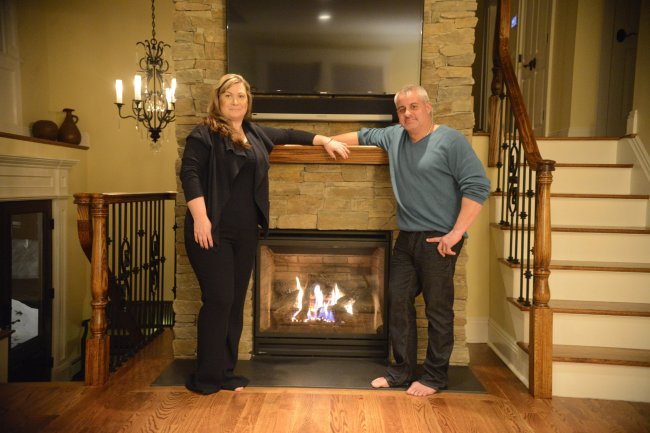HACKENSACK, New Jersey ― Vikki Ruisch had a fireplace in her house, but it was in a room her family barely used. So during a remodeling project last year, she had a fireplace built in her heavily trafficked living room, where everyone could enjoy it.
Ruisch figured it would add value to her Woodcliff Lake, New Jersey, house, but that wasn’t really an incentive. She grew up having a fireplace in her home and just wanted one, or two. She also had one put in the master bedroom.
“I don’t know anyone who doesn’t like a fireplace,” she said. “We use ours, especially this winter. My husband puts the one on in the bedroom when he gets up about an hour before me, and then it’s nice and toasty by the time I get up.”
Ruisch is one of many home and business owners installing fireplaces to add ambience, warmth and financial value to where they live and work. A fireplace can increase a home’s value by 6 to 12 percent, according to the National Center for Real Estate Research of Littleton, Colorado.
In addition to the standard stone or brick fireplaces found in typical settings like single-family homes and ski lodges, temporary hearths can be installed in the tiniest of apartments and the most intimate of restaurants.
 |
Vikki and John Ruisch put in two fireplaces when they had their house renovated in 2013, one in the master bedroom and another in the living room. (The Record/MCT) |
Ventless fireplaces are a swiftly growing segment of the market, targeted for apartments or other buildings where permanent changes can’t be made. Those that run on electricity can, with the flip of a switch, heat a space up to about 37 square meters, or, in hot weather operate with no warming element.
One manufacturer, HearthCabinet Ventless Fireplaces in New York City, offers products that use alcohol gel cartridges instead of electricity, said Sara Check, marketing and sales manager for the company.
“Lots of people wanted a fireplace and didn’t have a chimney, gas line or vent,” Check said. “So we are filling a void in a niche market. The cartridges work like a sterno canister works. You can replace the top and then use it again.”
One of the drawbacks to ventless fireplaces, specifically because there is no way to send gases outside the building, is that they often emit an odor, similar to the smell from an oven when it is on. But Check said HearthCabinet throws off little, if any odor, because of the gel cartridges it uses.
“Since our cartridges use isopropyl alcohol, our emissions don’t really have an odor,” she said.
Ventless fireplaces offer a variety of decorative options including ceramic logs, glass tips or river stones. They can range in size from about 60 centimeters to 1 meter wide and stand about 60 centimeters high.
Direct vent fireplaces are also growing in popularity, after starting in restaurants and other commercial businesses, like hotels, and are now becoming more common in homes, said Jason Conklin, manager of KJB Fireplaces in Ramsey, New Jersey.
“Usually they are linear fireplaces, only about 50 centimeters tall but stretch 1.5 or 1.8 meters wide,” Conklin said.
For single-family homes, sealed vent fireplaces, which use gas and burn air from the outside, are more popular. They are highly efficient at heating rooms and with a sharp decorative door, don’t look much different from a typical fireplace, industry experts say.
“Years ago, these weren’t the greatest looking things, but they’ve come a long way,” Conklin said. “Now they air-brush the logs to make them look real, and many times you can’t tell the difference.”
Ron Gaglione, owner of RDG Construction in Franklin Lakes, New Jersey, is still partial to the standard stone-and-mortar style. Natural stone, installed by an experienced craftsman, makes a fireplace a true asset to a home but is less popular because of the expense, Gaglione said.
“The cost is 25 percent to 30 percent more for one of these, so the demand is limited,” Gaglione said. “But I have a passion for real construction ― they are beautiful.”
Typical wood-burning fireplaces offer a slew of choices, including brick, wood, marble, stone or a combination, said Conklin.
“Years ago, wood-burning fireplaces were about 70 percent of our business. Now they’re about 40 percent,” Conklin said. “People want the convenience of gas where they can just push a button rather than having to haul wood into their house and work to keep the fire going. And though electric fireplaces are gaining in popularity, they’re only about 4 percent to 5 percent of our business.”
Regardless of the type, fireplaces are often sought by buyers, real estate experts say.
Nationwide, 13 percent of buyers of single-family homes had a fireplace on their list of particular features they were seeking. In the Northeast, that number rose to 16 percent, according to the 2013 National Association of Realtors report.
“In this area of the country, fireplaces, without a doubt, add character and value to the house,” said Emilia Freitag of Better Homes and Gardens Rand Realty in Ridgefield, New Jersey. People are very excited when they see a fireplace, especially with the winter we’ve been having. A fireplace definitely helps sell a house, and as for adding value, you could add $1,000 to $5,000 to the price of the house, especially if it has stone around it.”
Ruisch, who chose a marble fireplace for her bedroom and a two-story stone facade for the living room, didn’t really consider the resale value.
“We went with gas because it’s cleaner and my daughter has asthma,” Ruisch said. “It also lights and heats up the room so much quicker than a wood-burning one, and I can adjust the height of the flame. Fireplaces add value to my home, but even if they didn’t, I just love having them.”
By Barbara Williams
(The Record)
(MCT Information Services)








